Key takeaways:
- Increased vegetable intake can lead to higher energy levels, improved digestion, and better overall health, significantly reducing the risk of chronic diseases.
- Overcoming vegetable aversions can be achieved through exposure, positive mindset changes, and creative cooking techniques, transforming perceptions into appreciation.
- Involving family in meal prep and experimenting with seasonal produce enhances the enjoyment of vegetables and fosters a sense of community.
- Making vegetables the main focus of meals and using proper preparation methods, such as roasting or blending into smoothies, can elevate their appeal and nutritional value.
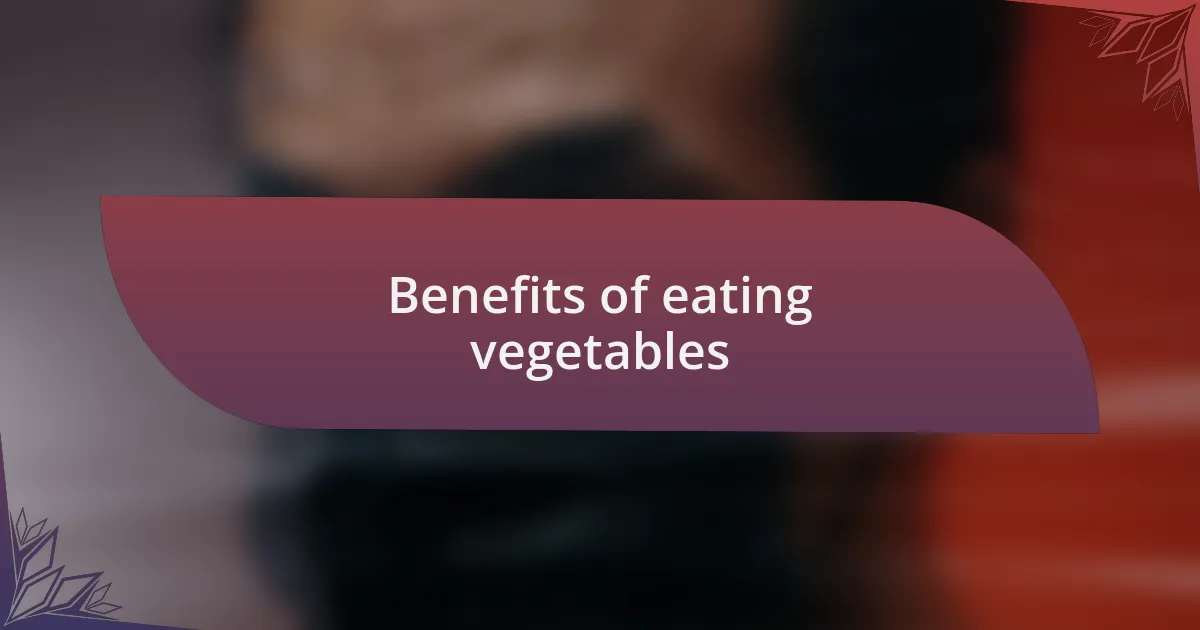
Benefits of eating vegetables
Eating vegetables is one of the simplest yet most profound changes I made to my diet, and the benefits are truly remarkable. For instance, I noticed that when I increased my vegetable intake, my energy levels soared. Have you ever felt that mid-afternoon slump? I used to, but now, incorporating greens helps me power through the day with vibrant energy.
Moreover, the variety of flavors and textures in vegetables can transform a meal into something exciting. One time, I experimented with roasted Brussels sprouts, tossing them with olive oil and garlic. As I took my first bite, I was surprised by the richness and depth of flavor—who knew vegetables could be so delicious? It drove home the point that these colorful foods play a crucial role in improving overall health.
Perhaps one of the most compelling benefits of eating vegetables lies in their role in disease prevention. I’ve learned that a diet high in these nutrient-dense foods can significantly lower the risk of chronic diseases like heart disease and diabetes. Isn’t it reassuring to know that something as simple as a salad can contribute to a longer, healthier life?
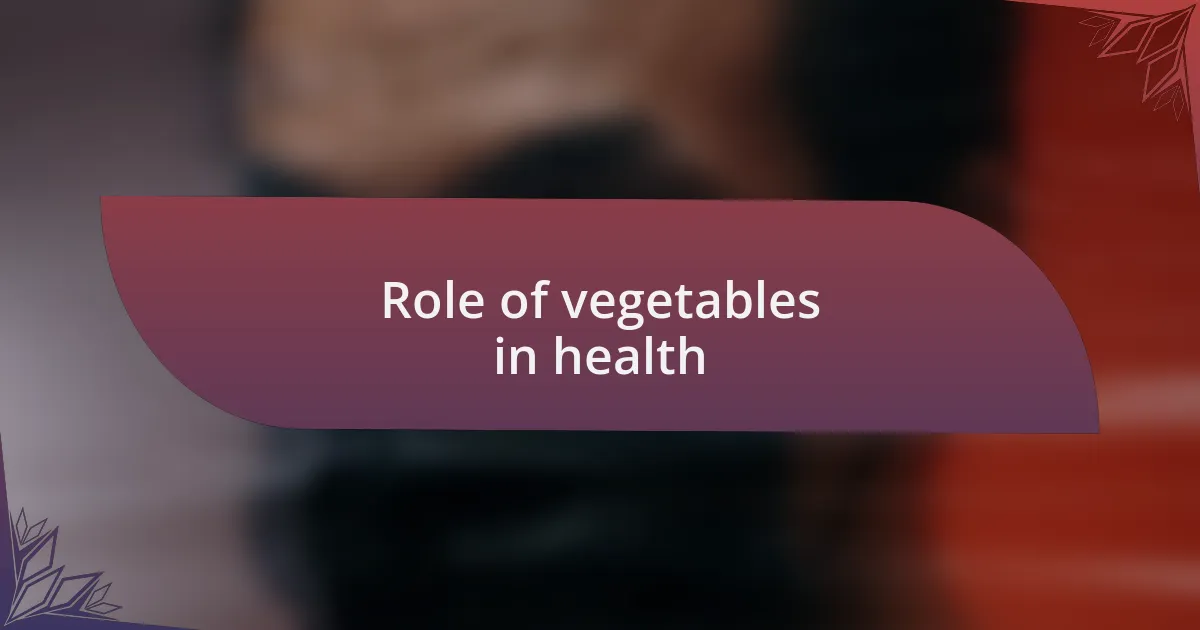
Role of vegetables in health
Eating vegetables is essential not just for maintaining a healthy weight, but also for supporting overall body function. I remember when I started including a rainbow of veggies in my meals, I felt like I was fueling my body with high-quality ingredients. Have you ever tried a stir-fry loaded with colorful bell peppers, broccoli, and carrots? It’s not just visually appealing; it’s quite energizing, thanks to the vitamins and minerals found in these vibrant foods.
The fiber content in vegetables played a crucial role in my health journey as well. Initially, I didn’t realize how important fiber was until I experienced improved digestion and even a more stable mood. Feeling that sluggishness lift made me appreciate my body’s needs in a way I previously overlooked. This awareness emphasized how vegetables are not just side dishes, but key players in overall wellbeing.
Moreover, I can’t help but think about vegetables as nature’s multivitamins. When I made it a point to include darker leafy greens and cruciferous vegetables in my meals, I noticed a marked improvement in my skin health and immune resilience. How incredible is it that the simplest of foods can have such a profound impact on how we feel day-to-day? It’s a reminder that embracing vegetables can truly enhance our quality of life.
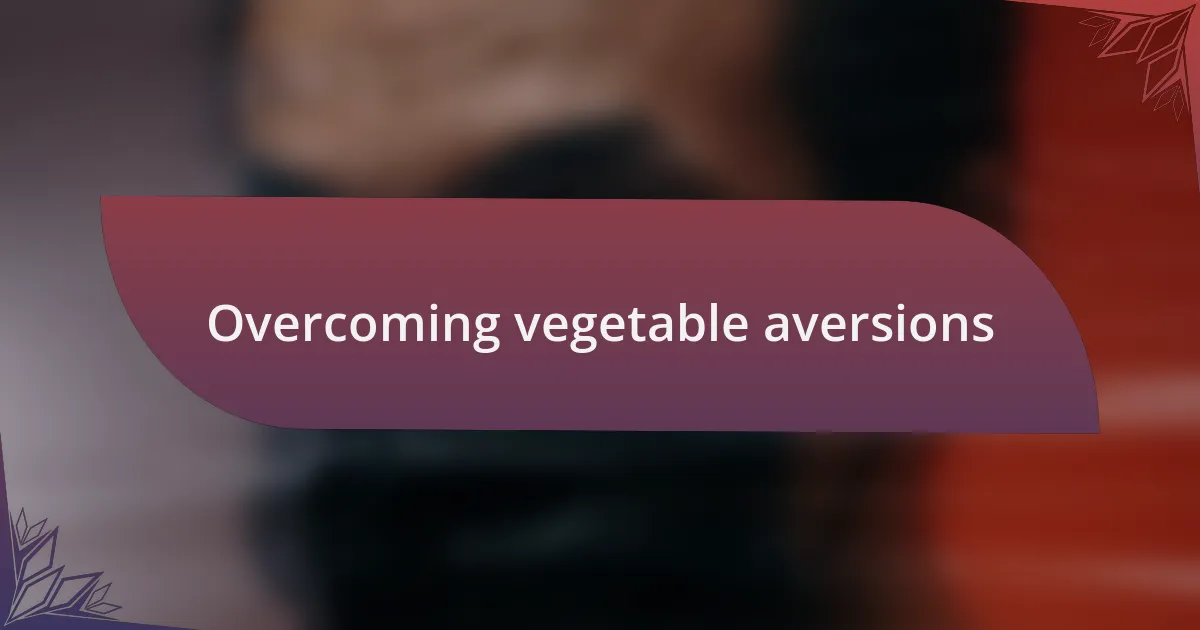
Overcoming vegetable aversions
Overcoming vegetable aversions can feel daunting, but it often starts with simple exposure. I remember the first time I decided to give Brussels sprouts another shot. Roasting them with a sprinkle of olive oil and sea salt transformed my perception from childhood disdain to adult appreciation. Have you ever tasted an ingredient in a new way and wondered how you could have missed out before?
Another strategy I found effective was incorporating vegetables into dishes I already loved. For example, adding shredded zucchini to my favorite pasta recipe was a game-changer. It blended right in, and I hardly noticed it was there at first! This little sneaky tactic allowed me to gradually expand my palate without feeling overwhelmed.
Creating a positive mindset around vegetables also played a crucial role in my journey. I started to celebrate their vibrant colors and distinct flavors rather than seeing them as merely a chore. When I began to think of vegetables as delicious opportunities for creativity in the kitchen, rather than obligations at the dinner table, I noticed my cravings shifting toward these nutritious delights. What if our feelings about vegetables changed simply by changing our perspective?
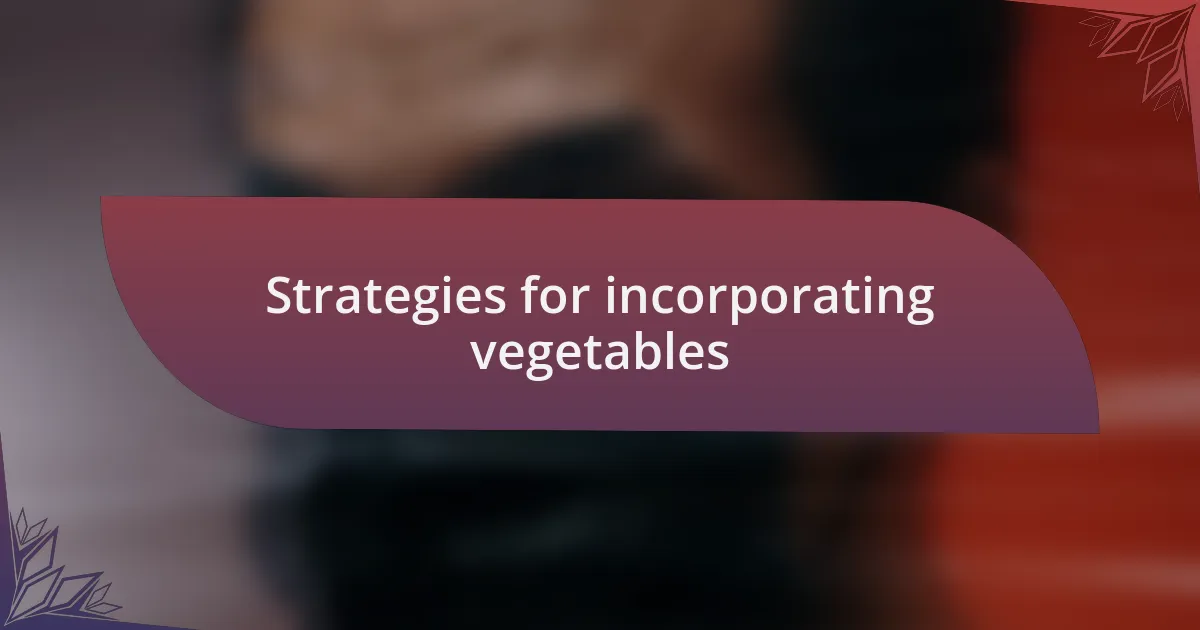
Strategies for incorporating vegetables
Experimenting with different cooking techniques opened up a whole new world of flavors for me. I recall one evening where I decided to spiralize some carrots and toss them into a colorful stir-fry. The crunch and sweetness of the carrots, paired with vibrant bell peppers, made for a dish that felt fresh and exciting. Have you ever realized how a different preparation technique can completely alter your experience with an ingredient?
Another effective strategy was involving my family in meal prep. I fondly remember our weekend cooking sessions, where each of us picked a vegetable to highlight. When my niece chose butternut squash, we roasted it with cinnamon and honey, transforming it into something we all eagerly devoured. That shared experience not only made trying new vegetables fun but also built lasting memories around cooking together.
Lastly, I began to embrace seasonal vegetables and local produce. Visiting farmers’ markets became a delightful ritual for me. There’s something invigorating about selecting fresh produce and feeling connected to the community. It’s like discovering a treasure trove of flavors! Have you noticed how fresh veggies just seem to taste better? I’ve found that when I enjoy the shopping process, I’m much more motivated to experiment with and savor what I bring home.

Discovering new vegetable recipes
Discovering new vegetable recipes is like embarking on a culinary adventure. I remember a rainy Sunday when I stumbled upon a recipe for roasted Brussels sprouts with balsamic glaze. I was hesitant at first, recalling my childhood dislike for them, but the idea of caramelized edges and a tangy finish intrigued me. As they roasted in the oven, the aroma filled my kitchen, and I found myself excited to taste something I once avoided.
One evening, I decided to challenge myself by trying a vegetable I had never cooked with before: eggplant. I came across a vibrant baba ganoush recipe, and I was drawn in by the simplicity of roasting the eggplant until its skin charred. The transformation was astounding; once blended with tahini and garlic, it became a creamy, velvety dip that paired perfectly with fresh pita. Has a dish ever surprised you with how delicious it could be? It was a turning point for me, proving that stepping outside my comfort zone could bring delightful surprises.
Another time, I joined a virtual cooking class focused on Mediterranean dishes, and we made a fennel salad. I had never even considered eating fennel raw, but the combination of its anise flavor with citrus and herbs was awakening. The vibrant colors, textures, and flavors opened my eyes to how vegetables could truly shine. I left that class feeling inspired and eager to try more dishes — I’m sure many of you can relate to that feeling of culinary discovery!
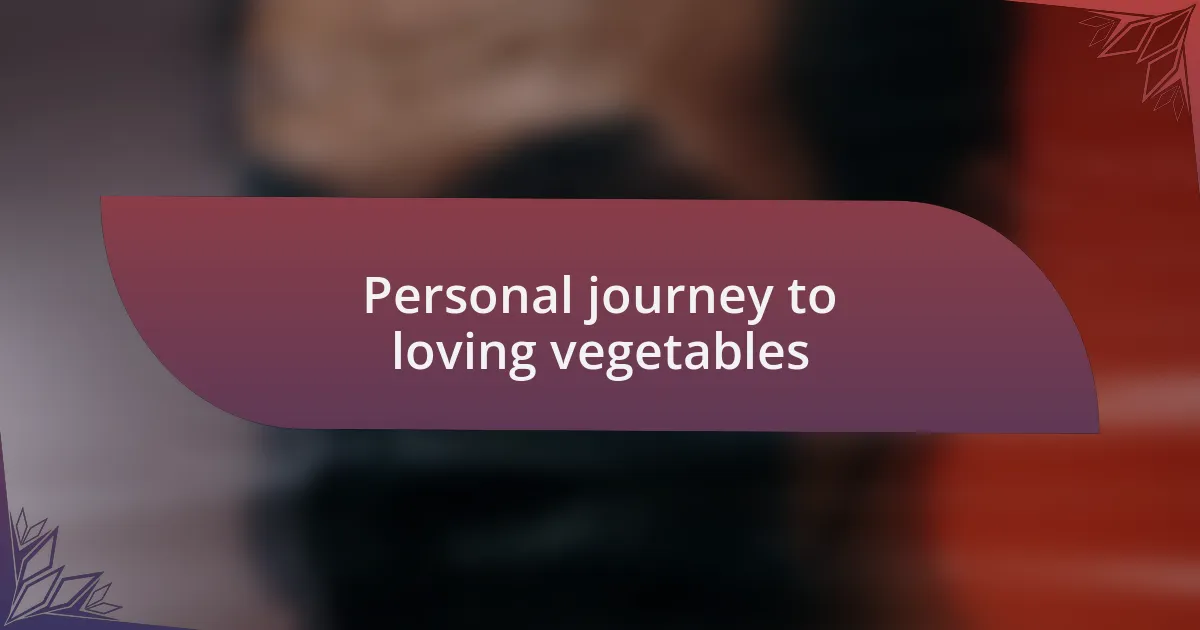
Personal journey to loving vegetables
There was a time when my plate was pretty bare when it came to veggies—think bland salads and overcooked green beans. It wasn’t until I decided to cook for a gathering of friends that everything changed. I found myself experimenting with colorful vegetable skewers, marinating zucchini and bell peppers in a spicy herb blend. Watching my friends devour them, I felt this unexpected wave of pride; it was a reminder that vegetables could be far more than just a side dish, sparking something new in my relationship with food.
Another memorable moment came when I joined a local community garden. Being surrounded by fresh produce and chatting with fellow gardeners made everything feel more vibrant. One day, I harvested a basket of cherry tomatoes and couldn’t resist popping one in my mouth right then and there. The burst of sweetness was a revelation! It was an experience that reminded me that eating vegetables could be not only healthy but also joyfully delicious. Have you ever tasted something so fresh that it changed your perspective entirely?
Lastly, I decided to embark on a 30-day vegetable challenge—no junk food, just a variety of veggies every day. Initially, it was daunting, but as I began sharing my plates on social media, I noticed more people engaging with my journey. The support fueled my creativity in the kitchen. Who knew that discovering the joy of experimenting with different flavor profiles could lead to lasting friendships and a sense of community? The entire experience not only transformed my palate but also reinforced the importance of embracing what’s good for our health in a joyful and delicious way.

Tips for a vegetable-rich diet
When it comes to incorporating more vegetables into your diet, I’ve found that preparation methods can make all the difference. For example, roasting broccoli with a splash of olive oil and garlic can elevate its flavor immensely. I still remember the first time I pulled a tray of golden-brown roasted veggies from the oven; it completely changed my perspective on what veggies could taste like. Have you ever tried a simple cooking method that turned a vegetable you once disliked into a favorite?
Another tip that worked wonders for me was blending veggies into smoothies. I was skeptical at first, but adding spinach or kale to a fruit smoothie turned out to be a game-changer. Not only did it add nutrients without compromising the taste, but it also felt like a secret way to pack in those greens. It’s fascinating how a single scoop of veggies can enhance a drink; have you ever considered sneaking in those nutrient-packed greens?
Finally, I discovered the power of making vegetables the star of the meal rather than an afterthought. I started experimenting with hearty vegetable stews, where the veggies are not just components but part of the dish’s heart and soul. The first time I shared a steaming pot of ratatouille with friends, their compliments felt like validation for my efforts. How many times have you thought about making veggies the highlight of your meals? It’s a small shift that can lead to a much richer and more satisfying dining experience.